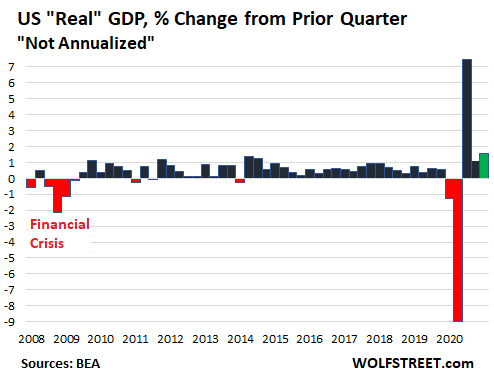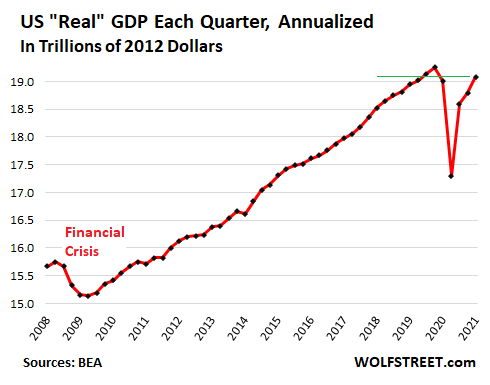Inflation Jumped by 3.8% in Q1, “Real GDP” Rose 1.6%, Dragged Down by Record Trade Deficit and Drop in Inventories
Even the Fed’s repressed inflation measure without food and energy rose 2.3% annual rate in Q1.
The US economy, as measured by inflation-adjusted GDP, grew by 1.6% in the first quarter from Q4 2020, according to the advance estimate of the Bureau of Economic Analysis this morning.
If you read in the headline that it grew by “6.4%,” that sounded impressive, but it was “annualized”; it essentially multiplied the quarterly growth rate (1.6%) by 4. There are not many countries outside the US, if any, that report “annualized” GDP growth rates, because they’re really just misleading for normal people.

GDP inflation jumped by 3.8%, PCE inflation by 3.5%.
The BEA’s broadest inflation measure, the price index that roughly parallels the inflation adjustment to GDP (the “price index for gross domestic purchases”), jumped by 3.8% annual rate in Q1, more than double the rate of 1.7% in Q4.
The BEA’s narrower PCE (“personal consumption expenditure”) price index jumped by 3.5% annual rate in Q1.
And the BEA’s price index that has become the Fed’s measure for inflation, “core PCE” (PCE without food and energy) rose by 2.3% annual rate, tracking above the Fed’s former target of 2.0%. “Former target” because now the Fed is looking for inflation above 2%.
GDP in dollars.
In dollar terms, real GDP in Q1 amounted to a “seasonally adjusted annual rate” of $19.09 trillion. This was still down about 0.9% from the peak in Q4 2019 – catching up:

Consumer spending rose 2.6% from the prior quarter to an annual rate of $13.3 trillion in “chained 2012 dollars” (to adjust for inflation), a tad below the peak in Q4 2019.
*****

